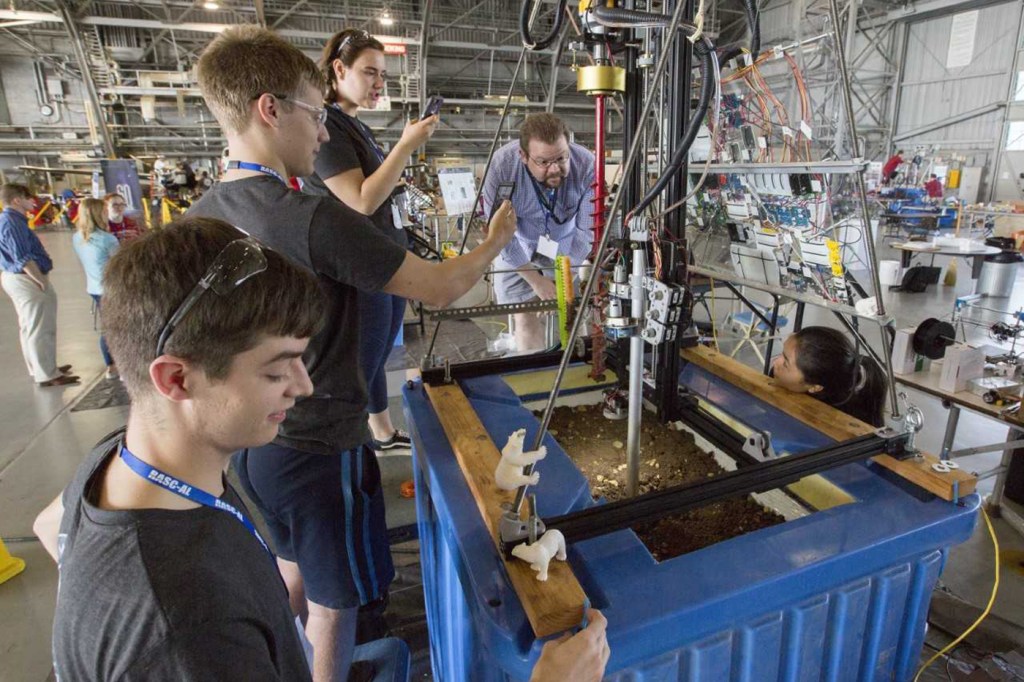Northeastern students win NASA’s Mars Ice Challenge with a robot built to extract water from the Red Planet

A team of Northeastern students has won the 2018 NASA Mars Ice Challenge, bringing the world one small step closer to sending people to the Red Planet.
For manned Martian missions to be possible, astronauts will need a lot more water than they can carry on a spacecraft. There is plenty of water on Mars, but most of it is trapped under a thick layer of dirt and ice. NASA and other international space organizations want to gain access to those underground rivers.
Enter six Northeastern engineering students. They built a remote-operated robotic device comprised of a drill, an excavator, and a heating element to penetrate the dirt, melt the ice, and pump clean water up to the surface.
The Northeastern team got to test its system on Thursday at the NASA Langley Research Center in Hampton, Virginia, competing against eight other universities in a quest to see which device could extract the greatest amount of water from a simulated Martian surface.
Northeastern won by a landslide, collecting 3,209 milliliters of water. The second-place team collected around 800 milliliters of water.
What made Northeastern’s system so superior? The device’s design allowed it to drill fewer holes but excavate more surface area than other machines. That meant the system could pull out more water with less effort.
“The other thing that helped was that the people on this team are brilliant engineers and built a system that was reliable, robust, and could withstand the competition environment,” said team member Daniel McGann, a third-year engineering student.
The competition was divided into two days. On day one, teams were allowed to tinker with their devices to fix any last-minute issues. But day two was hands-off, meaning teams could only control their systems remotely. This was a critical part of the design specifications, since NASA will eventually want a device that can go a step further and work autonomously.
Early on in day two, disaster struck. The tubes of the Northeastern team’s device got clogged.

Northeastern professor Taskin Padir, far left, led a team of Northeastern engineering students to a first-place finish in NASA’s 2018 Mars Ice Challenge. Photo by NASA Langley / David C. Bowman
“For the majority of the day, we thought we weren’t going to get any water,” said team member Ben Zinser, a second-year engineering student. They first tried submerging the device in water, hoping to dissolve the dirt. When that didn’t work, they lifted out the extractor and turned up the heating element. After a while, all the water in the extractor’s tube evaporated, leaving the dusty sediment, which easily passed through, clearing the blockage.
“Once we finally got the tube unclogged, it was just a continuous stream of water,” Zinser said. “It was really incredible.”
The troubleshooting was all done remotely, a feat that impressed the judges so much that they gave the Northeastern team special recognition at the award ceremony. In addition to winning the competition, the team received $3,000 to continue its research to improve the device.
Since the ultimate goal is to send a water extraction device to Mars, a space-ready system must adhere to certain design specifications. For example, any water pumped to the planet’s surface would evaporate immediately in the frigid temperatures and suffocating atmosphere of Mars.
“Mars isn’t going to be nice to us,” said team member Emilia Kelly, a second-year engineering student. “We will need a system that creates an environment in which the pressure and temperature are things we can regulate.”
Kelly is starting a co-op this summer at NASA’s Jet Propulsion Laboratory, where she’ll begin tackling these types of engineering challenges.
In addition to McGann, Kelly, and Zinser, the team includes engineering students Andrew Panasyuk, Elisa Danthinne, and Patrick Moore.
“NASA and the other international space organizations are serious about getting man to Mars, and harvesting water is a critical capability,” said Taskin Padir, associate professor of electrical and computer engineering, who serves as the team’s faculty advisor. “This is the beginning of a major journey to make that real. These guys are onto something.”




